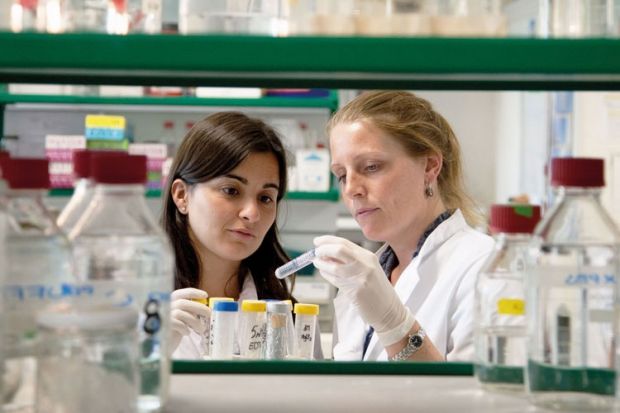Female academics have won just 10 per cent of the latest tranche of the European Research Council’s flagship advanced grants, while UK researchers took nearly one quarter of the total.
The highly prestigious grants, typically worth up to €2.5 million (£1.8 million), are awarded to individual researchers working on “frontier” research. Awardees should have “a recent high-level research track-record and profile which identifies them as leaders in their respective field(s)”.
According to the statistics for the 2014 round, released on 30 June, women account for just 19 of the 190 awardees. Of the 25 award-making panels, 12 made no awards to females, including two out of the nine panels in the life sciences, six out of 10 in the physical sciences and engineering, and four out of six in social sciences and humanities.
In the previous round of advanced grants, in 2013, women accounted for 13 per cent of awardees. However, a spokesman for the ERC said that significantly fewer women had applied in this round. Of the 2,287 applications, just 310 came from women, or 13.4 per cent of the total. The female success rate was 6.1 per cent, compared with 8.6 per cent for men.
The spokesman also pointed out that in the most recent round of consolidator grants, aimed at mid-career researchers, women were slightly more successful than men, taking 28 per cent of the grants, with a success rate of 15.2 per cent, compared with 14.9 per cent for men.
He said the issue of low female representation among grantees was “something we are working on”.
UK-based researchers are even more successful in this round of advanced grants than they were in 2013, securing 45 awards (23.7 per cent of the total, compared with 22.9 in 2013). The next most successful countries were Germany, with 29 (15.3 per cent) awards and France with 23 (12.1). Grants were made to researchers in a total of 17 countries.
British is also the most common nationality among grant winners. British researchers, of whom seven work abroad, won 38 awards (20 per cent of the total, compared with 18.7 per cent in 2013). Germans won 33 (17.4 per cent) grants and Dutch researchers 18 (9.5 per cent). Grants were awarded to 23 nationalities overall.
The overall success rate of the 2014 round was just 8.3 per cent (10.4 for the life sciences, 7.9 for the physical sciences and engineering and 6.5 in social sciences and humanities). This compares with 12.3 per cent in the 2013 round and reflects what Jean-Pierre Bourguignon, president of the ERC, said was “particularly fierce” competition in this round.
“Many more than the 190 laureates would have deserved support. The scientists responsible for the selection…were faced with a very difficult task of choosing proposals bold enough to provide radical new knowledge while having a good chance of being successful," he said.
The 2014 awards are worth a total of €445 million (£317 million), compared with more than €660 million awarded in the previous round of advanced grants, which was divided between 284 researchers.
Low success rate for Horizon 2020 applicants
Only 14 per cent of researchers applying for funding under the first work programme of Horizon 2020 secured funding. The initial overall success rate is down 7 percentage points compared with that of its predecessor, the Seventh Framework Programme.
Speaking at a Westminster Higher Education Forum event about priorities for science and innovation, Alan Cross, deputy head of unit A3 at the European Commission’s Directorate-General for Research and Innovation, presented the headline results of Horizon 2020’s first funding call.
The first work programme received 31,000 proposals since it was published in December 2013. About 120,000 applicants were involved in bids to apply for the €15 billion available in the first two years of Horizon 2020, he said at the event in London today.
In total, researchers asked for €53.4 billion (£38 billion), giving them a success rate in terms of value of 14.4 per cent. In terms of the number of proposals the success rate was 13.9 per cent. Mr Cross said that the first work programme was “seven times oversubscribed”.
By contrast, FP7 had a success rate of about 20 per cent, with one in five bids securing funding.
Mr Cross said that there could be a “whole bundle of factors” behind the dip in success rates. The time gap between the last call of FP7 and the first call Horizon 2020 could have led to “pent up demand” and a surge in applications, he said.
In addition, funding available in the final call of FP7 was slightly less than that available for the first call of Horizon 2020. “Also in many countries national funding is drying up so more participants are turning to Europe,” he said, stressing that the results should be treated with caution as it is still early data.
He said that the target for small and medium-size enterprise involvement of 20 per cent had been met, but that international participation was down compared with FP7.
Register to continue
Why register?
- Registration is free and only takes a moment
- Once registered, you can read 3 articles a month
- Sign up for our newsletter
Subscribe
Or subscribe for unlimited access to:
- Unlimited access to news, views, insights & reviews
- Digital editions
- Digital access to THE’s university and college rankings analysis
Already registered or a current subscriber? Login





